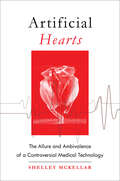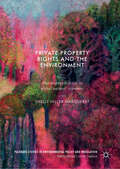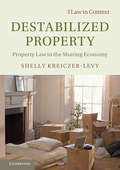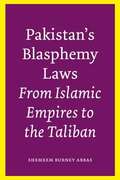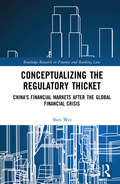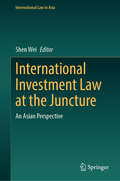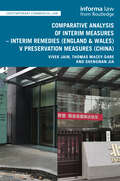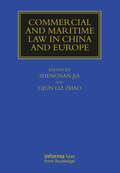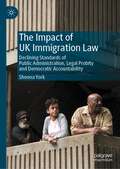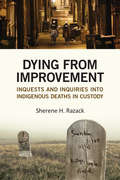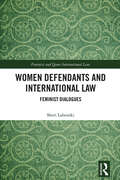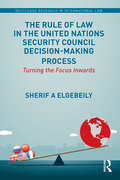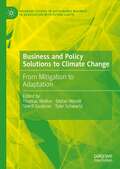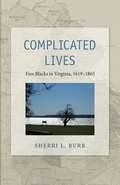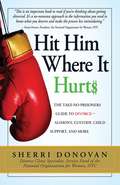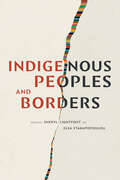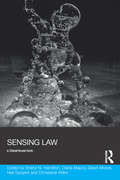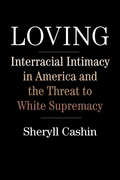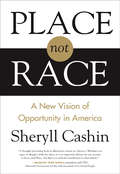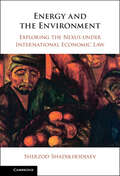- Table View
- List View
Artificial Hearts: The Allure and Ambivalence of a Controversial Medical Technology
by Shelley McKellarA comprehensive history of the development of artificial hearts in the United States.Artificial hearts are seductive devices. Their promissory nature as a cure for heart failure aligned neatly with the twentieth-century American medical community’s view of the body as an entity of replacement parts. In Artificial Hearts, Shelley McKellar traces the controversial history of this imperfect technology beginning in the 1950s and leading up to the present day. McKellar profiles generations of researchers and devices as she traces the heart’s development and clinical use. She situates the events of Dr. Michael DeBakey and Dr. Denton Cooley’s professional fall-out after the first artificial heart implant case in 1969, as well as the 1982–83 Jarvik-7 heart implant case of Barney Clark, within a larger historical trajectory. She explores how some individuals—like former US Vice President Dick Cheney—affected the public profile of this technology by choosing to be implanted with artificial hearts. Finally, she explains the varied physical experiences, both negative and positive, of numerous artificial heart recipients. McKellar argues that desirability—rather than the feasibility or practicality of artificial hearts—drove the invention of the device. Technical challenges and unsettling clinical experiences produced an ambivalence toward its continued development by many researchers, clinicians, politicians, bioethicists, and the public. But the potential and promise of the artificial heart offset this ambivalence, influencing how success was characterized and by whom. Packed with larger-than-life characters—from dedicated and ardent scientists to feuding Texas surgeons and brave patients—this book is a fascinating case study that speaks to questions of expectations, limitations, and uncertainty in a high-technology medical world.
Private Property Rights and the Environment: Our Responsibilities to Global Natural Resources (Palgrave Studies in Environmental Policy and Regulation)
by Shelly Hiller MargueratThis book explores the current notion and definition of property, and its interpretation and implementation in relation to the environment. The author examines two primary problems: the degradation of land, natural resources and animal abuse; and the increasing erosion of private property rights from property owners by the arbitrary interference of state governments. Examining texts from antiquity to contemporary legislation, it portrays the historical development of the understanding of “nature” as “property” and discusses our obligations towards the environment. Drawing on the most influential political-philosophical texts from all periods of property rights history, the author analyzes modern national and international legislation and case law to offer legally-grounded evidence and explanations. This book advocates the incorporation of a formula that guarantees the protection of property rights into the legal system, and imposes clear and effective responsibility on property owners to limit the use of natural resources and the abuse of animals. This book will appeal to practitioners, researchers and students with an interest in environmental and private property law.
Destabilized Property: Property Law in the Sharing Economy (Law in Context)
by Shelly Kreiczer-LevyThe sharing economy challenges contemporary property law. Does the rise of access render our conception of property obsolete? What are the normative and theoretical implications of choosing casual short-term use of property over stable use? What are the relational and social complications of blurring the line between personal and commercial use of property? The book develops a novel conceptualization of property in the age of the sharing economy. It argues that the sharing economy pushes for a mobile and flexible vision of engaging with possessions and, as a result, with other people. Property's role as a source of permanence and a facilitator of stable, long-term relationships is gradually decreasing in importance. The book offers a broad theoretical and normative framework for understanding the changing landscape of property, provides an institutional analysis of the phenomenon, discusses the social, communal, and relational implications of these changes, and offers guidelines for law reform.
Pakistan's Blasphemy Laws: From Islamic Empires to the Taliban
by Shemeem Burney AbbasUnder the guise of Islamic law, the prophet Muhammad's Islam, and the Qur'an, states such as Pakistan, Afghanistan, Egypt, Saudi Arabia, and Bangladesh are using blasphemy laws to suppress freedom of speech. Yet the Prophet never tried or executed anyone for blasphemy, nor does the Qur'an authorize the practice. Asserting that blasphemy laws are neither Islamic nor Qur'anic, Shemeem Burney Abbas traces the evolution of these laws from the Islamic empires that followed the death of the Prophet Muhammad to the present-day Taliban. Her pathfinding study on the shari'a and gender demonstrates that Pakistan's blasphemy laws are the inventions of a military state that manipulates discourse in the name of Islam to exclude minorities, women, free thinkers, and even children from the rights of citizenship. Abbas herself was persecuted under Pakistan's blasphemy laws, so she writes from both personal experience and years of scholarly study. Her analysis exposes the questionable motives behind Pakistan's blasphemy laws, which were resurrected during General Zia-ul-Haq's regime of 1977-1988--motives that encompassed gaining geopolitical control of the region, including Afghanistan, in order to weaken the Soviet Union. Abbas argues that these laws created a state-sponsored "infidel" ideology that now affects global security as militant groups such as the Taliban justify violence against all "infidels" who do not subscribe to their interpretation of Islam. She builds a strong case for the suspension of Pakistan's blasphemy laws and for a return to the Prophet's peaceful vision of social justice.
China's Foreign Investment Law in the New Normal: Framing the Trajectory and Dynamics
by Shen WeiThis book analyzes China's foreign investment law which came into force in January 2020. The new law implemented sweeping changes and overhauled China’s foreign investment law regime of the last four decades. The foreign investment law aims to make the business environment more investor-friendly and address some of the contentious issues between US and China in the ongoing trade war. The book explains how the law enhances regulatory transparency. It also outlines the new approval process, that is the pre-establishment negative list system which has replaced the former approval system for foreign investment projects. This book will help give readers a better understanding of major changes and benefits under the new law and will be the first of its kind looking at the implications of this law.
Conceptualizing the Regulatory Thicket: China's Financial Markets after the Global Financial Crisis (Routledge Research in Finance and Banking Law)
by Shen WeiThis book examines the regulatory framework, regulatory objectives, regulatory logics, regulatory instruments, regulatory failures, and regulatory responses in China’s financial market after the global financial crisis. The book provides an in-depth analysis of China’s contemporary financial regulatory system, focusing on risks, regulation, and policies in practice. By drawing on public and private interest theories relating to financial regulation, the book contends that the controlled development of the banking sector, and the financial sector generally, has transformed China’s banks into more market-oriented institutions and increased public sector growth. However, China’s financial market and financial regulation have some inherent weaknesses and deficiencies. This book also offers insights into how this can be improved or adapted to minimize systemic risks in China’s financial sector. This book tries to prove that financial regulation is not just a vehicle for maintaining efficient financial markets but a primary tool through which the Chinese government achieves its political and economic objectives. More fundamentally, according to the law and finance theory, strong market and vibrant judicial systems are needed to further modernize China’s financial markets and market economy. The book will be a useful reference for anyone interested in learning from the Chinese experience.
Decoding Chinese Bilateral Investment Treaties
by Shen WeiThis is a major work investigating China's bilateral investment treaties (BITs) regime through various approaches including textual analysis, case study, comparative study and empirical study. This book tries to unveil some of the puzzles in Chinese BITs. The general consensus is that the evolution of China's BIT regime has its underlying logic, which follows an investment liberalization trend and fits China's changing role from a key capital-importing state to a major capital-exporting state. A similar trend is evident in Chinese BIT-making and BIT policy. This book investigates these theoretical assumptions and looks into some of the loopholes in Chinese BITs.
International Investment Law at the Juncture: An Asian Perspective (International Law in Asia)
by Shen WeiThe book focuses on some of the most pressing issues in international investment law in Asia, such as the role of developing countries, the rebalancing between the investors’ rights protection and the host states’ right to regulate, the ISDS reform, among others. The book investigates these issues by looking into the bilateral investment treaties and investment arbitration cases in the region. The readers will benefit from this book’s rich content and wide coverage. For instance, the readers would learn more about Asian states’ Bilateral Investment Treaty law and practice and their standing on international investment law. The book provides a fresh angle to most readers who may be more exposed to the Western perspective on the topic, providing a more complete picture to add to the readers’ understanding of international investment law and in particular its evolution and future possibilities.
Comparative Analysis of Interim Measures – Interim Remedies (Contemporary Commercial Law)
by Vivek Jain Thomas Macey-Dare Shengnan JiaInterim remedies and provisional measures are a critical component of civil/commercial litigation and arbitration. The objective of this book is to set out not just the law and practice in relation to the primary interim remedies and preservation measures available in England & Wales and China, but also to provide the comparative analysis between the two jurisdictions concerning these interim measures. The system for interim remedies in England & Wales is well-established, but preservation measures in China are a work in progress and many differences exist between the two legal systems, both in terms of theory and practice. For example, China does not recognise the general concept of interim measures, if looked at from the English law point of view, though it does have similar concepts of Property preservation, evidence preservation and behaviour preservation. China has recently adopted Chinese Civil Code 2020 and in writing this book the authors have incorporated all the relevant elements from the new Code. There is no equivalent of Practice Directions in China, and this book provides provide much needed clarity on this area, drawing together the law and guidance which is presently scattered across numerous local courts in the different provinces. This is an important book that is likely to have a significant impact on existing scholarship regarding interim remedies in England, Wales and China, and be of interest of all parties involved in cross-border litigation. Its readership will include industry professionals, academics, policy-makers and government officials.
Commercial and Maritime Law in China and Europe (Maritime and Transport Law Library)
by Shengnan Jia and Lijun Liz ZhaoBoth China and Europe have a long tradition of commercial and maritime law; and this new book examining various topics from their particular perspectives is both timely and important. It links the vital component of maritime law with commercial law, financial law and trade policy. The book has performed a remarkable task in making connections between China and Europe through the lenses of substantive and procedrual laws, covering a wide range of areas, including commercial law, insurance law, salvage, EU maritime law and Brexit, carriage of goods by sea, arbitration, mediation, litigation, the recently formed China International Commercial Court, and different liability regimes, as well as a brief look forward into new initiatives and artificial intelligence in the digital age. In these challenging times, we all have much to learn from each other in seeking to find answers to what are often difficult problems. This book provides a welcome opportunity for anyone interested in commercial and maritime law to engage in that learning exercise and, looking ahead, thereby to help solve such problems as may arise in the future – in a practical and fair manner. It is therefore of great relevance to both the academic field and the legal practice field in China and Europe.
The Impact of UK Immigration Law: Declining Standards of Public Administration, Legal Probity and Democratic Accountability
by Sheona YorkThis book provides an insightful analysis of recent developments in immigration, asylum and citizenship law in the broader social and political context. Written accessibly by an experienced practitioner, it critically examines the development of UK immigration control since the second world war, identifying and focusing on the grievous collateral damage being caused to the rule of law and to society. It examines the decline in standards of public administration, the secular failure to follow the rule of law, and the related issues of social corrosion and lack of democratic accountability. Speaking to academics, practitioners, policy makers and all those concerned about the impact of the hostile environment, it makes proposals for legal changes which prioritise social cohesion: a shared burden of proof, a simple regularisation scheme and clear path to citizenship, and details how these would operate in practice.
Nothing Has to Make Sense: Upholding White Supremacy through Anti-Muslim Racism (Muslim International)
by Sherene H. RazackHow Western nations have consolidated their whiteness through the figure of the Muslim in the post-9/11 world While much has been written about post-9/11 anti-Muslim racism (often termed Islamophobia), insufficient attention has been given to how anti-Muslim racism operates through law and is a vital part of law&’s protection of whiteness. This book fills this gap while also providing a unique new global perspective on white supremacy. Sherene H. Razack, a leading critical race and feminist scholar, takes an innovative approach by situating law within media discourses and historical and contemporary realities. We may think of law as logical, but, argues Razack, its logic breaks down when the subject is Muslim. Tracing how white subjects and majority-white nations in the post-9/11 era have consolidated their whiteness through the figure of the Muslim, Razack examines four sites of anti-Muslim racism: efforts by American evangelical Christians to ban Islam in the school curriculum; Canadian and European bans on Muslim women&’s clothing; racial science and the sentencing of Muslims as terrorists; and American national memory of the torture of Muslims during wars and occupations. Arguing that nothing has to make sense when the subject is Muslim, she maintains that these legal and cultural sites reveal the dread, phobia, hysteria, and desire that mark the encounter between Muslims and the West. Through the prism of racism, Nothing Has to Make Sense argues that the figure of the Muslim reveals a world divided between the deserving and the disposable, where people of European origin are the former and all others are confined in various ways to regimes of disposability. Emerging from critical race theory, and bridging with Islamophobia/critical religious studies, it demonstrates that anti-Muslim racism is a revelatory window into the operation of white supremacy as a global force.
Dying from Improvement
by Sherene RazackNo matter where in Canada they occur, inquiries and inquests into untimely Indigenous deaths in state custody often tell the same story. Repeating details of fatty livers, mental illness, alcoholic belligerence, and a mysterious incapacity to cope with modern life, the legal proceedings declare that there are no villains here, only inevitable casualties of Indigenous life.But what about a sixty-seven-year-old man who dies in a hospital in police custody with a large, visible, purple boot print on his chest? Or a barely conscious, alcoholic older man, dropped off by police in a dark alley on a cold Vancouver night? Or Saskatoon's infamous and lethal starlight tours, whose victims were left on the outskirts of town in sub-zero temperatures? How do we account for the repeated failure to care evident in so many cases of Indigenous deaths in custody?In Dying from Improvement, Sherene H. Razack argues that, amidst systematic state violence against Indigenous people, inquiries and inquests serve to obscure the violence of ongoing settler colonialism under the guise of benevolent concern. They tell settler society that it is caring, compassionate, and engaged in improving the lives of Indigenous people - even as the incarceration rate of Indigenous men and women increases and the number of those who die in custody rises.Razack's powerful critique of the Canadian settler state and its legal system speaks to many of today's most pressing issues of social justice: the treatment of Indigenous people, the unparalleled authority of the police and the justice system, and their systematic inhumanity towards those whose lives they perceive as insignificant.
Break Point: Two Minnesota Athletes and the Road to Title IX
by Sheri BrendenHow two teenage girls in Minnesota jump-started a revolution in high school athletics Peggy Brenden, a senior, played tennis. Toni St. Pierre, a junior, was a cross country runner and skier. All these two talented teenagers wanted was a chance to compete on their high school sports teams. But in Minnesota in 1972 the only way on the field with the boys ran through a federal court—so that was where the girls went. Break Point tells the story, for the first time, of how two teenagers took on the unequal system of high school athletics, setting a legal precedent for schools nationwide before the passage of Title IX.As Peggy&’s younger sister, author Sheri Brenden is uniquely positioned to convey the human drama of the case, the stakes, and the consequences for two young women facing the legal machinery of the state, in court and in school. In an account that begins with Peggy painstakingly typing her appeal to the Minnesota Civil Liberties Union and concludes with a long view of what Brenden v. Independent School District 742 set in motion, Sheri Brenden summons the salient details of this landmark case as it makes its way through the courts. Peggy and Toni, coaches, administrators, and experts testify before Judge Miles Lord, whose decision, upheld in a precedent-setting appeal, would change these girls&’ lives and open up athletic opportunities for innumerable others.Grounded in newspaper coverage, court records, and interviews, Brenden&’s deeply researched, scrupulously reported book is at heart the story of two talented teenage girls whose pluck and determination—and, often, heartache—led to a victory much greater than any high school championship.
Women Defendants and International Law: Feminist Dialogues (Feminist and Queer International Law)
by Sheri LabenskiThis book addresses the largely neglected place of women defendants in contemporary international criminal law, beyond the construction of women as victims, and asks what the analysis of women perpetrators, defendants and suspects reveals about international criminal law, the media and feminism.The book uses the topic of women perpetrators, defendants and suspects as a way to explore the concept of legal subjectivity via a gender analysis. It highlights how women perpetrators, defendants and suspects are constituted through three spheres, namely the areas of international criminal law, the media and feminism. In examining the relationship between women perpetrators, defendants and suspects and each of these spheres, the book exposes embedded gender biases and structural gender fractures. These reveal that problematic assumptions about how gender operates in conflict are embedded in the very foundations of legal imaginations. Ultimately, the book argues that this has far reaching consequences, beyond its impact on current understandings of armed conflict. Rather, these assumptions should be a concern for us all, even in times of peace.This book will be of use to legal academics and practitioners interested in gender within international criminal law, as well as those concerned with contemporary feminist approaches to law.
The Rule of Law in the United Nations Security Council Decision-Making Process: Turning the Focus Inwards (Routledge Research in International Law)
by Sherif ElgebeilyThe UN Security Council is entrusted under the UN Charter with primary responsibility for the maintenance and restoration of the international peace; it is the only body with the power to authorise military intervention legally and impose international sanctions where it decides. However, its decision-making process has hitherto been obscure and allegations of political bias have been made against the Security Council in its responses to potential international threats. Despite the rule of law featuring on the Security Council’s agenda for over a decade and a UN General Assembly declaration in 2012 establishing that the rule of law should apply internally to the UN, the Security Council has yet to formulate or incorporate a rule of law framework that would govern its decision-making process. This book explains the necessity of a rule of law framework for the Security Council before analysing existing literature and UN documents on the domestic and international rule of law in search of concepts suitable for transposition to the arena of the Security Council. It emerges with eight core components, which form a bespoke rule of law framework for the Security Council. Against this framework, the Security Council’s decision-making process since the end of the Cold War is meticulously evaluated, illustrating explicitly where and how the rule of law has been undermined or neglected in its behaviour. Ultimately, the book concludes that the Security Council and other bodies are unwilling or unable adequately to regulate the decision-making process against a suitable rule of law framework, and argues that there exists a need for the external regulation of Council practice and judicial review of its decisions.
Business and Policy Solutions to Climate Change: From Mitigation to Adaptation (Palgrave Studies in Sustainable Business In Association with Future Earth)
by Thomas Walker Sherif Goubran Stefan Wendt Tyler SchwartzThis edited book aims to ignite both an academic and practitioner-oriented discussion regarding the question how the business and government sector can adapt to today’s fast-changing climate. Specifically, the collection seeks to explore how businesses and policy makers can prepare for a world where freshwater is scarce, extreme weather events are common, floods and wildfires are frequent, and global sea levels rise by more than two meters. In addition to assessing incremental approaches, it explores strategies that employ interdisciplinary and innovative solutions to climate change adaptation. The chapters included in this book examine and propose business and policy solutions for climate-induced economic, technical, urban, and societal challenges. It draws on an international range of prominent authors and, therefore, will be of interest for academics and practitioners working in the field of sustainability management, sustainable finance, sustainable operations management, food management, strategy, and environmental management. It can also serve as a valuable guide for practitioners and policymakers in those fields.
Complicated Lives: Free Blacks in Virginia, 1619-1865
by Sherri BurrWould the United States have developed differently if Virginia had not passed a law in 1670 proclaiming all subsequently arriving Africans as servants for life, or slaves? Complicated Lives upends the pervasive belief that all Africans landing on the shores of Virginia in late August 1619, and thereafter, became slaves. In reality, many of these kidnap victims received the status of indentured servants. Indeed, hundreds of thousands of free African Americans owned property, created businesses, and engaged in public service. Complicated Lives explores the lives of Free Blacks through the lens of the author's ancestors and other Free Blacks who lived this history, including those who served in the integrated troops commanded by George Washington during the Revolutionary War. "Complicated Lives is a much-needed chronicle of the achievements and plight of Free Blacks in America, and how many of our nation's Founding Fathers and notables struggled with the dichotomy of slavery and freedom. This is a scholarly work that belongs on the shelves of all worthy historians, but also reads like a novel, making it approachable to the lay reader." --FRANK ALAN BURR, author of McKinley Memories--A Memoir
Hit Him Where It Hurts: The Take-No-Prisoners Guide to Divorce--Alimony, Custody, Child Support, and More
by Sherri DonovanA Simon & Schuster eBook. Simon & Schuster has a great book for every reader.
Impersonations
by Sheryl HamiltonPersonhood is considered at once a sign of legal-political status and of socio-cultural agency, synonymous with the rational individual, subject, or citizen. Yet, in an era of life-extending technologies, genetic engineering, corporate social responsibility, and smart technology, the definition of the person is neither benign nor uncontested. Boundaries that previously worked to secure our place in the social order are blurring as never before. What does it mean, then, to be a person in the twenty-first century?In Impersonations, Sheryl N. Hamilton uses five different kinds of persons - corporations, women, clones, computers, and celebrities - to discuss the instability of the concept of personhood and to examine some of the ways in which broader social anxieties are expressed in these case studies. She suggests that our investment in personhood is greater now than it has been for years, and that our ongoing struggle to define the term is evident in law and popular culture. Using a cultural studies of law approach, the author examines important issues such as whether the person is a gender-neutral concept based on individual rights, the relationship between personhood and the body, and whether persons can be property.Impersonations is a highly original study that brings together legal, philosophical, and cultural expressions of personhood to enliven current debates about our place in the world.
Indigenous Peoples and Borders
by Sheryl Lightfoot and Elsa StamatopoulouThe legacies of borders are far-reaching for Indigenous Peoples. This collection offers new ways of understanding borders by departing from statist approaches to territoriality. Bringing together the fields of border studies, human rights, international relations, and Indigenous studies, it features a wide range of voices from across academia, public policy, and civil society. The contributors explore the profound and varying impacts of borders on Indigenous Peoples around the world and the ways borders are challenged and worked around. From Bangladesh’s colonially imposed militarized borders to resource extraction in the Russian Arctic and along the Colombia-Ecuador border to the transportation of toxic pesticides from the United States to Mexico, the chapters examine sovereignty, power, and obstructions to Indigenous rights and self-determination as well as globalization and the economic impacts of borders. Indigenous Peoples and Borders proposes future action that is informed by Indigenous Peoples’ voices, needs, and advocacy.Contributors. Tone Bleie, Andrea Carmen, Jacqueline Gillis, Rauna Kuokkanen, Elifuraha Laltaika, Sheryl Lightfoot, David Bruce MacDonald, Toa Elisa Maldonado Ruiz, Binalakshmi “Bina” Nepram, Melissa Z. Patel, Manoel B. do Prado Junior, Hana Shams Ahmed, Elsa Stamatopoulou, Liubov Suliandziga, Rodion Sulyandziga, Yifat Susskind, Erika M. Yamada
Sensing Law (Social Justice)
by Sheryl N. Hamilton, Diana Majury, Dawn Moore, Neil Sargent and Christiane WilkeA rich collection of interdisciplinary essays, this book explores the question: what is to be found at the intersection of the sensorium and law’s empire? Examining the problem of how legal rationalities try to grasp what can only be sensed through the body, these essays problematize the Cartesian framework that has long separated the mind from the body, reason from feeling and the human from the animal. In doing so, they consider how the sensorium can operate, variously, as a tool of power or as a means of countering the exercise of regulatory force. The senses, it is argued, operate as a vector for the implication of subjects in legal webs, but also as a powerful site of resistance to legal definition and determination. From the sensorium of animals to technologically mediated perception, the ways in which the law senses and the ways in which senses are brought before the law invite a questioning of the categories of liberal humanism. And, as this volume demonstrates, this questioning opens up the both interesting and important possibility of imagining other sensual subjectivities.
Loving: Interracial Intimacy in America and the Threat to White Supremacy
by Sheryll CashinHow interracial love and marriage changed history, and may soon alter the landscape of American politics.Loving beyond boundaries is a radical act that is changing America. When Mildred and Richard Loving wed in 1958, they were ripped from their shared bed and taken to court. Their crime: miscegenation, punished by exile from their home state of Virginia. The resulting landmark decision of Loving v. Virginia ended bans on interracial marriage and remains a signature case—the first to use the words “white supremacy” to describe such racism.Drawing from the earliest chapters in US history, legal scholar Sheryll Cashin reveals the enduring legacy of America’s original sin, tracing how we transformed from a country without an entrenched construction of race to a nation where one drop of nonwhite blood merited exclusion from full citizenship. In vivid detail, she illustrates how the idea of whiteness was created by the planter class of yesterday and is reinforced by today’s power-hungry dog-whistlers to divide struggling whites and people of color, ensuring plutocracy and undermining the common good.Cashin argues that over the course of the last four centuries there have been “ardent integrators” and that those people are today contributing to the emergence of a class of “culturally dexterous” Americans. In the fifty years since the Lovings won their case, approval for interracial marriage rose from 4 percent to 87 percent. Cashin speculates that rising rates of interracial intimacy—including cross-racial adoption, romance, and friendship—combined with immigration, demographic, and generational change, will create an ascendant coalition of culturally dexterous whites and people of color.Loving is both a history of white supremacy and a hopeful treatise on the future of race relations in America, challenging the notion that trickle-down progressive politics is our only hope for a more inclusive society. Accessible and sharp, Cashin reanimates the possibility of a future where interracial understanding serves as a catalyst of a social revolution ending not in artificial color blindness but in a culture where acceptance and difference are celebrated.
Place, Not Race
by Sheryll CashinFrom a nationally recognized expert, a fresh and original argument for bettering affirmative action Race-based affirmative action had been declining as a factor in university admissions even before the recent spate of related cases arrived at the Supreme Court. Since Ward Connerly kickstarted a state-by-state political mobilization against affirmative action in the mid-1990s, the percentage of four-year public colleges that consider racial or ethnic status in admissions has fallen from 60 percent to 35 percent. Only 45 percent of private colleges still explicitly consider race, with elite schools more likely to do so, although they too have retreated. For law professor and civil rights activist Sheryll Cashin, this isn't entirely bad news, because as she argues, affirmative action as currently practiced does little to help disadvantaged people. The truly disadvantaged--black and brown children trapped in high-poverty environs--are not getting the quality schooling they need in part because backlash and wedge politics undermine any possibility for common-sense public policies. Using place instead of race in diversity programming, she writes, will better amend the structural disadvantages endured by many children of color, while enhancing the possibility that we might one day move past the racial resentment that affirmative action engenders. In Place, Not Race, Cashin reimagines affirmative action and champions place-based policies, arguing that college applicants who have thrived despite exposure to neighborhood or school poverty are deserving of special consideration. Those blessed to have come of age in poverty-free havens are not. Sixty years since the historic decision, we're undoubtedly far from meeting the promise of Brown v. Board of Education, but Cashin offers a new framework for true inclusion for the millions of children who live separate and unequal lives. Her proposals include making standardized tests optional, replacing merit-based financial aid with need-based financial aid, and recruiting high-achieving students from overlooked places, among other steps that encourage cross-racial alliances and social mobility. A call for action toward the long overdue promise of equality, Place, Not Race persuasively shows how the social costs of racial preferences actually outweigh any of the marginal benefits when effective race-neutral alternatives are available.From the Hardcover edition.
Energy and the Environment: Exploring the Nexus under International Economic Law
by Sherzod ShadikhodjaevEnergy intersects with the environment at all stages of its life cycle by affecting nature and public health and is subject to government measures concerning low-carbon growth, energy efficiency and conservation, renewable energy and ecologically safe supply of nuclear and other energy resources. This timely book provides a comprehensive analysis of the role of international economic law in regulating such an energy-environment nexus under the regimes of the WTO, the Energy Charter Treaty, regional trade agreements and investment treaties. The author discusses the international environmental and economic law foundations of this nexus and extensively examines relevant rules, jurisprudence and practices regarding trade restrictions, subsidies, technical standards, investment protection and technology policies. This book highlights the existing gaps and 'greening' solutions within the framework of international economic law. Where relevant, it draws comparisons between trade law and investment law to show their similarities, differences and (potential) conflicts at the energy-environment interface.
